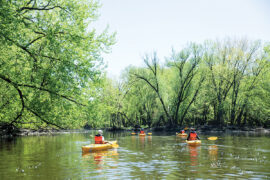Iconic Trees Give Growing Hint of Old Mississippi Wetlands
People can hardly think of the Deep South without envisioning giant bald cypress trees. Defying time for hundreds, perhaps thousands of years, these wooden goliaths flourish in wetlands from eastern Texas across Mississippi to Delaware and north up the Mississippi River Valley from the Gulf of Mexico to southern Illinois.
They thrive where other terrestrial plants quickly perish. Broad trunks and extensive root systems steady the trees growing in the shifting, loose muck, despite periodic batterings by powerful storms.
Unique to cypress trees, large “root balls” sprout from the trunks. “Knees,” hard, pyramid-shaped extensions of the root system, poke up from the mud to surround these wetland wonders like mini sentinels guarding the tree. Nobody really knows the purpose of these knees, but many theorize that they help trees breathe, sort of like a wooden snorkel for trees that typically grow in wet mud or standing water up to seven feet deep.
Many cypress trees grow more than 120 feet tall with trunks six feet in diameter. Found near Williamsburg, Va. the tallest known southern colossus reaches 145 feet tall, nearly half of a football field. A tree from Texas spread to a trunk circumference of nearly 40 feet. On the Black River in North Carolina, the oldest known still living specimen and oldest live tree in eastern North America, sprouted at least 2,624 years old, about 600 years before the time of Julius Caesar.
Impervious to rot and insects, cypress lumber makes an excellent, highly valuable building material, especially in a place with a warm, wet and humid climate such as southern Mississippi. In the mid-19th century, vast cypress forests covered the lowlands along the Gulf Coast. Not easily accessible with the technology of the time, these primordial forests remained largely intact as lumber companies focused on easier to reach trees. Finally, technology advanced to the point where people could reach, harvest and retrieve these ancient swamp behemoths. This kicked off a massive logging boom across Mississippi and throughout the post-Civil War South.
In the late 19th and early 20th centuries, entire towns dependent upon this valuable resource sprang up at the edge of many swampy rivers like the Pearl. Logtown, once a bustling town on East Pearl River in extreme southern Hancock County derived its name from the lucrative lumber business. In the 1890s, the largest lumber company in the United States employed more than 1,200 of Logtown’s 3,000 citizens.
By 1930, few old-growth cypress trees remained and the lumber boom went bust. Now, little remains of Logtown except a few old house foundations, merely small clearings in the regrown forests near the remnants of driveways and old cemeteries located on property now part of the John C. Stennis Space Center. People can hike the Possum Walk Trail where Logtown once stood or launch kayaks at the Bayou Bogue Homa bridge.
Today, these ubiquitous southern symbols, frequently draped with Spanish moss, still punctuate swamps and line parts of many Mississippi rivers including the Pearl and Pascagoula. Now mostly young trees that grew up after the lumber boom ended dominate these wetland forests. However, a few ancient wind-twisted trunks, commonly hollow and missing their top halves after numerous storms over the centuries, still provide a glimpse of what these Gulf Coast swamps once looked like not so long ago.





